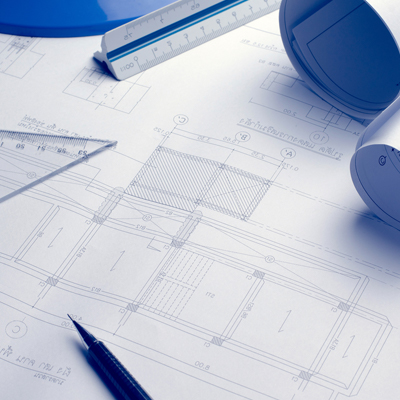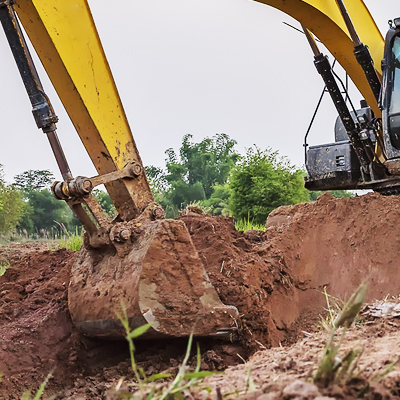Structural Repair
Gibson's Pressure Grouting Service also specializes in structural repair using polyurethane epoxy injection. Structural restoration of concrete with polyurethane epoxy injection is very often the only alternative to complete replacement of a damaged structural concrete member.
Cracks In Structural Members
A crack, obviously, is a sign of failure caused by stresses, inadequate design, or improper curing of the concrete during construction. One of the dangers of a structural crack is the effect that it has on the reinforcing bar inside. The reinforcing bar or "rebar" represents one of the main structural components of any concrete structure. Cracks left un-repaired allow moisture, salts and other contaminants to penetrate into the concrete and attack the rebar. The rebar oxidizes or deteriorates, losing its structural integrity. If left unchecked loss of the entire concrete structure can often be the result.
Epoxy injection protects the rebar and stops water leakage and is a technique for "welding" cracks in concrete back together. This often restores the concrete structure to its original strength and load design specifications.
In other words - under most conditions epoxy injection makes the concrete as good as new. It creates an impervious seal to air, water, chemicals, debris, and other contamination.
Delaminating of Concrete Structures
Delaminating of concrete structures is an area where epoxy injection can also offer selective repair.
Prime examples are bridge decks or other self supporting structures, where the most common delamination is shearing of the concrete. This is commonly at the upper rebar mat.
Another common situation is the hollow plane that develops when concrete bridge piers are resurfaced or the old piers are encased in new concrete. Hollow planes develop, especially against the smooth sections of the old pier. Cracking then occurs on the surface perpendicular to the hollow plane. Delamination then occurs along the hollow planes that run along the reinforcing bar.
The epoxy resin, when injected, will travel or flow through these hollow plane areas for several feet filling in the voids and preventing further delamination.
Gibson's Pressure Grouting Service uses epoxy injection to repair and restore damaged concrete structures and members. We repair bridges, overpasses, and reinforced concrete decks, pillars, posts, and columns.
We use a SIKADUR product that we feel is the one of the worlds finest polyurethane resins system to in our repairs. This multi-purpose injection resin is designed to seal leaking cracks, voids or fractures in concrete structures.
Many specialty grouts can be used with an accelerator to adjust the reaction profile as needed for job site conditions. The system can be accelerated to achieve specific reaction times by mixing in specific amounts of accelerator.
Cracks In Structural Members
A crack, obviously, is a sign of failure caused by stresses, inadequate design, or improper curing of the concrete during construction. One of the dangers of a structural crack is the effect that it has on the reinforcing bar inside. The reinforcing bar or "rebar" represents one of the main structural components of any concrete structure. Cracks left un-repaired allow moisture, salts and other contaminants to penetrate into the concrete and attack the rebar. The rebar oxidizes or deteriorates, losing its structural integrity. If left unchecked loss of the entire concrete structure can often be the result.
Epoxy injection protects the rebar and stops water leakage and is a technique for "welding" cracks in concrete back together. This often restores the concrete structure to its original strength and load design specifications.
In other words - under most conditions epoxy injection makes the concrete as good as new. It creates an impervious seal to air, water, chemicals, debris, and other contamination.
Delaminating of Concrete Structures
Delaminating of concrete structures is an area where epoxy injection can also offer selective repair.
Prime examples are bridge decks or other self supporting structures, where the most common delamination is shearing of the concrete. This is commonly at the upper rebar mat.
Another common situation is the hollow plane that develops when concrete bridge piers are resurfaced or the old piers are encased in new concrete. Hollow planes develop, especially against the smooth sections of the old pier. Cracking then occurs on the surface perpendicular to the hollow plane. Delamination then occurs along the hollow planes that run along the reinforcing bar.
The epoxy resin, when injected, will travel or flow through these hollow plane areas for several feet filling in the voids and preventing further delamination.
Gibson's Pressure Grouting Service uses epoxy injection to repair and restore damaged concrete structures and members. We repair bridges, overpasses, and reinforced concrete decks, pillars, posts, and columns.
We use a SIKADUR product that we feel is the one of the worlds finest polyurethane resins system to in our repairs. This multi-purpose injection resin is designed to seal leaking cracks, voids or fractures in concrete structures.
Many specialty grouts can be used with an accelerator to adjust the reaction profile as needed for job site conditions. The system can be accelerated to achieve specific reaction times by mixing in specific amounts of accelerator.


